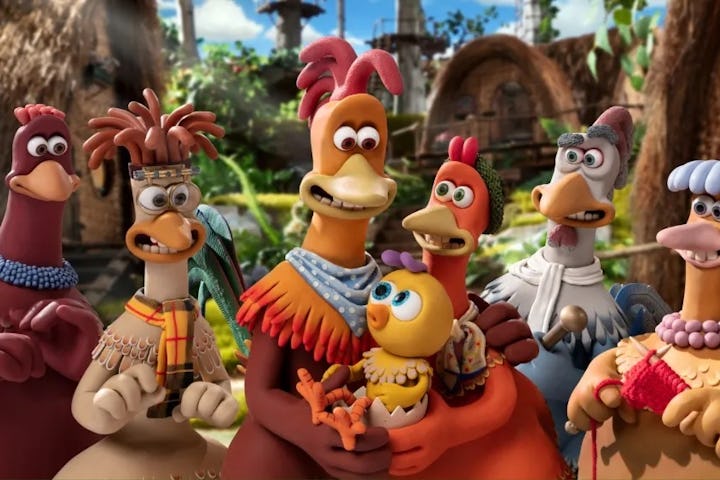23 Years Later, Chicken Run Swaps Rom-Com Vibes For Something Unexpected
Why the new Chicken Run will make parents who loved the first film, feel seen.

It’s been nearly a quarter-century since a group of claymation chickens busted out of the farm they were imprisoned in. Things, understandably, have changed in those years between the original Chicken Run and the new sequel Chicken Run: Dawn of the Nugget, which hatched on Netflix today. Whereas the first movie was a riff on The Great Escape and other World War II movies, this has other influences. The main characters, Ginger and Rocky, are played by new voice actors. And, perhaps most importantly, Ginger and Rocky have a daughter now.
“Originally the first movie was a romantic comedy,” director Sam Fells tells Fatherly. “Rocky and Ginger — the relationship between this mismatched pair. Now this next chapter, what’s the next challenge for them? Well, it’s parenthood.”
Having escaped from Tweedys' farm at the end of the 2000 film, Ginger and Rocky, are living with the rest of the chickens in a blissful safe haven. Thandiwe Newton and Zachary Levi replace original actors Julia Sawalha and Mel Gibson, respectively, for the roles. The pair have a rambunctious daughter, Molly (Bella Ramsey), and all is well — until a new sort of poultry farm opens up and Molly finds herself trapped inside, prompting Ginger and Rocky to break in this time to save their daughter.
While Dawn of the Nugget feels very much the same as the original Chicken Run in terms of its look and general vibe (Fell notes that Aardman Animation’s style is basically the same as it was two decades ago, with some minor technological upgrades), there’s a bit of a more whimsical, zany style. Gone are the grays and mud you’d expect from a World War II flick, and in its place is a much more colorful, elaborate look that feels more like a 1960s spy show, especially The Prisoner. Fell likens the new film to the old Mission: Impossible (“Chicken: Impossible,” he jokes) or early James Bond movies, especially legendary production designer Ken Adams’ aesthetic.
“The first one is fabulous and brilliant and beloved, but I didn’t just want to make that carbon copy,” Fell says. Instead, Fell says he was “intrigued by the idea of a new era of farming and industrial food production,” and the film uses ‘60s spy tropes and designs to exaggerate how the farm has changed.
The movie’s title, Dawn of the Nugget, refers the the beginnings of factory farming and processed food, though it’s far more focused on the changes that happen when one becomes a parent than it is on the implications of agriculture techniques. Levi, who is probably best known as the hilarious and charming star of Shazam, tells Fatherly that Rocky’s journey from Yankee circus act to doting father is the key to the character.
“In the first one, he’s this hotshot bachelor rooster who then finds love and that kind of throws him for a loop, and now that love has led to a deeper love of them creating their own progeny. And now he’s a dad — and he’s a Girl Dad,” Levi explains. And, although Rocky does pine for the adventure and freedom of his youth at times (relatable!), he ultimately will put it all on the line for his daughter Molly.
“You don’t need to go back to that well of youth,” Levi says. “You can invest in this new adventure you’re on.”
“Sometimes when you become a parent, you think you have to put a part of you away,” Fell echoes, noting that many of the animators who worked on the first Chicken Run and this have since become parents themselves. “That’s what this story is about. Molly shows up and she’s more adventurous and brave and she wants to look out in the world, whereas Ginger is kind of inclined to turn her back on the world and become more protective. That dynamic gave us the heart of the story. Molly is the kid point of view. Ginger and Rocky are the adult point of view.”
“That was the genius of what Walt Disney, [Pixar’s] John Lasseter, and the whole crew at Ardman. They understand what makes really good quality, excellent, four-quadrant entertainment, and that’s not playing down to the kids,” Levi says. “It’s playing it straight and being intelligent with your writers and your plot, recognizing that if you make it kind of flashy and colorful and even silly enough in its own right, you’ll get the kids. They’re about it it.”